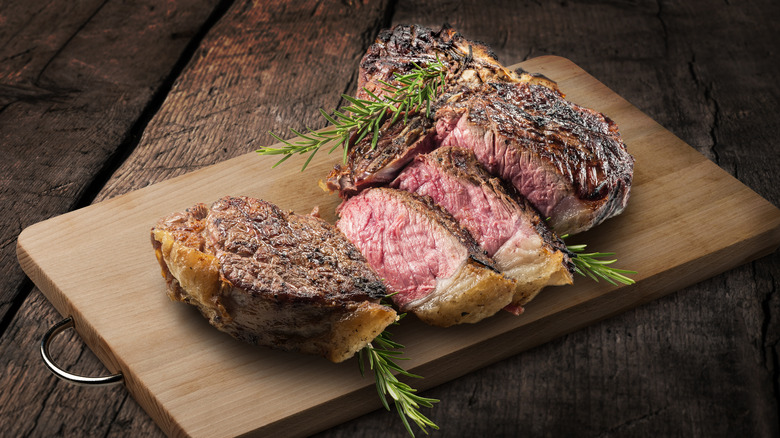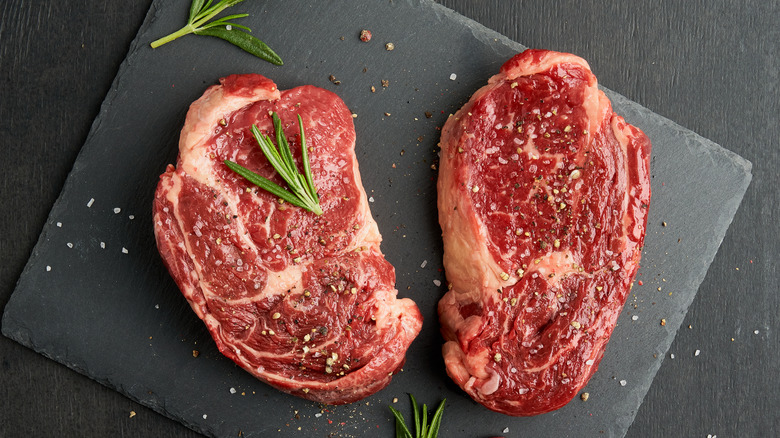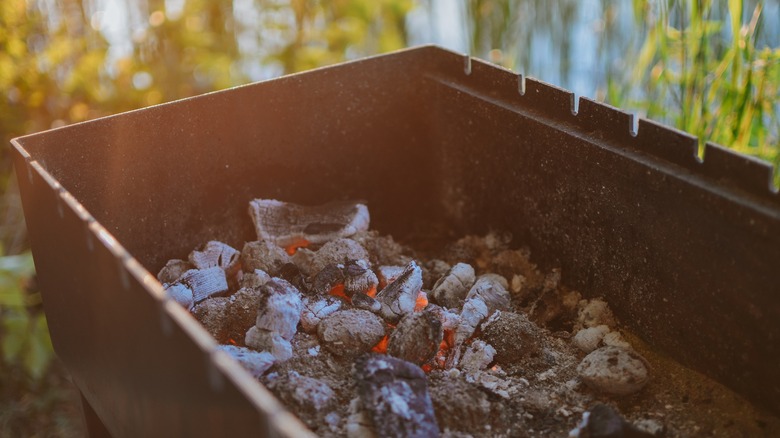Dirty Steak Is The Bizarre Cooking Method You Need To Try
"Dirty" probably isn't a word that you'd ordinarily want to associate with cooking. But, rather than referring to any grease or actual dirt, it can also be used to describe a very specific style of grilling. It involves placing the food directly on the coals, rather than on the grates — and it's a method that works especially well for cooking steak.
Also known as caveman steaks or Eisenhower steaks (the president was a fan of thick strip steaks prepared with this technique), dirty steak involves cooking at extremely high temperatures, which can reach around 1200 degrees Fahrenheit. The result is a stunning sear that creates intensely flavorful meat, charred on the outside but deliciously tender and juicy within.
While cooking on the coals is an incredibly simple technique in theory, there are several important steps to follow if you want to get the best results. These involve picking the most suitable cuts of steak, as well as using the right kind of charcoal and preparing it correctly. And, of course, you need a charcoal grill rather than gas too, thanks to the superior flavor the former provides.
Choose the right cut of steak for caveman cooking
Different cuts of steak suit different cooking methods, and this is especially true when you're dealing with the fiercely hot temperatures of white-hot coals. When you're making dirty steaks, you'll want to choose cuts of meat with similar thickness throughout for more even and consistent cooking, and also with good marbling for a juicy result. Options such as New York strip steak — one of the best cuts of steak to grill — work well; or you could try porterhouse, ribeye, sirloin, or T-bone.
Dirty cooking is a fast method, and it will only take around three to five minutes each side to sear a thick steak. Regular flipping can help to produce a more even finish. If you're worried that the meat will burn on the hot heat, don't; the coals don't have enough oxygen for a fire when the steak is cooked directly on them.
It's always important to rest meat for a while after grilling, too — around half the time that you cooked it is ideal — since it will continue to cook after you've removed it from the heat. This carryover cooking is even more pronounced with dirty steak. If you normally pull the protein off the grill when it's around 5 degrees Fahrenheit shy of the intended final temperature, you'll need to allow more like 15 degrees when cooking on the coals.
Prepare the coals for superior dirty steaks
When cooking a dirty steak, the type of charcoal matters more than ever. Go for good quality lumpwood charcoal, and avoid anything with chemicals (so don't use briquettes or accelerants). Carefully arrange the hot coals to get a good-sized, even cooking surface, and then remove any excess ash. Alton Brown uses a blow dryer to clean the coals before cooking steak on them, but you could also fan them using a newspaper.
While there is a trend for adding seasoning to the charcoal itself when grilling, it's advisable to season the steak instead when you're cooking directly on white-hot coals. Simple salt and pepper is all you really need, since the technique itself produces a naturally smoky taste. You could always try using woods such as hickory or pecan to switch up the flavor. Or boost the rich savory notes of the beef with a butter or sauce to serve alongside it — cowboy butter is the ideal accompaniment for steak cooked in this style.
If you're concerned that the finished steak may be overly ashy, you can use a natural bristle pastry brush to remove any excess before you eat it. Once you've perfected the technique, try using it for other meats or even vegetables, too. Pork chops, thick tuna steaks, lamb, or wedges of cauliflower all work well done dirty.



